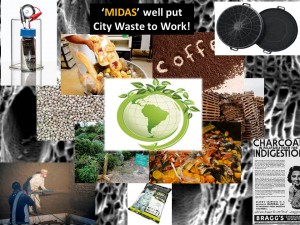 The notion of ‘waste’ is so last century. In the new century this stuff is pure gold and I believe it could be the cornerstone for making urban areas more sustainable and even regenerative. Waste optimization could also spur innumerable entrepreneurial ventures.
The notion of ‘waste’ is so last century. In the new century this stuff is pure gold and I believe it could be the cornerstone for making urban areas more sustainable and even regenerative. Waste optimization could also spur innumerable entrepreneurial ventures.
Waste conversion technologies are not new but next generation variants are gaining steam – some are even producing steam! Historically many have focused on how to convert waste into some type of energy which is obviously better than shipping it off to landfills. However newer versions of older technologies, such as thermochemical conversion (TC) create multiple end products including: heat, liquid biofuels and biochar, a highly stable form of carbon used as a soil amendment (also referred to as ‘char’ when not used in the soil). Multiple end-products allow for a more holistic approach to optimizing organic ‘waste’.
Here is a view on how cities can more closely mimic nature when it comes to managing their organics using TC technology.
Large scale TC equipment could be utilized at recycling centers where landscapers drop off tree debris which then generates heat & electricity for the recycling center, biogas to run the equipment, and biochar which could be added to compost to speed decomposition or used to reduce odors and control toxic leachate at local landfills or sold to generate income.
Smaller scale TC equipment could be used directly at the source of ‘waste’ generation such as food processors, restaurants, etc. where the heat & electricity could be used on-site to reduce costs and carbon footprints. Char could be sold to a third party where, depending on the characteristics of the char and the needs & priorities of the region, it could be made into a wide variety of locally made products including:
Building materials: Char-clay plaster could be sprayed over walls to retrofit buildings with poor insulation, humidity issues (possibly after floods to prevent mold) or lead paint concerns. Replacing cement with this highly sustainable product in new construction would materially improve the building’s carbon footprint.
Water filtration devices: Char filters could be used in food processing plants where organics are filtered out of the effluent. Once absorbed in char filters these nutrients could be recycled back to the soil.
Remediation: Urban brownfields render otherwise valuable land useless. Biochar can be used to economically revitalize these areas. Other cities ban growing food within city limits due to lead paint concerns in their soils. As some biochars can neutralize lead, this would allow more urban gardening and improve local food security.
Growing medium: Roof gardens, greenhouses, garden walls could all benefit from a lightweight, locally produced soil amendment, especially if it were boosted with nutrients from the food processing plant’s effluent! Biochar can also reduce the amount of water needed for growing plants.
Battery Storage: Early research shows potential for certain chars to be able to effectively replace rare earth metals in super capacitors & microbial fuel cell batteries.
Pet Products: Adding char to pet food improves health by removing pesticides used to grow much of the food found in animal feed. [Humans have ingested charcoal since ancient times as a means of detoxification!] Kitty litter char would be highly sustainable and would actually be beneficial when sent to a landfill.
If cities take a more holistic approach to waste optimization they can create a more vibrant entrepreneurial environment while simultaneously improving clean water availability, producing renewable energy and creating green jobs. The added bonus is that biochar can safely help rebalance atmospheric carbon levels.
[This blog post is part of Masdar’s 2014 Engage Blogging Contest.]

